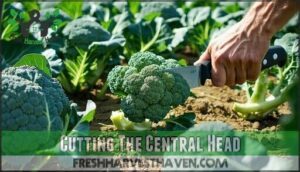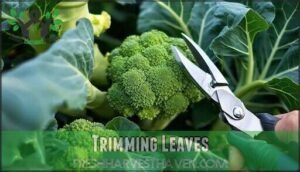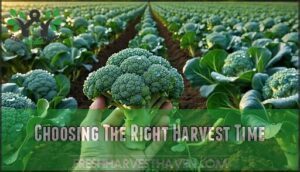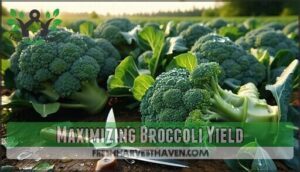This site is supported by our readers. We may earn a commission, at no cost to you, if you purchase through links.

Look for tight, dark green florets – once they start turning yellow or flowering, you’ve missed the sweet spot.
Cut the main head with a sharp knife, leaving about 2-3 inches of stem.
Don’t toss the plant! Those side shoots will keep producing smaller heads for weeks.
The best time? Early morning when the heads are crisp and cool.
Think of it as nature’s alarm clock for peak flavor and nutrition.
Table Of Contents
- Key Takeaways
- Broccoli Growth Stages
- Signs of Broccoli Readiness
- Tools Needed for Harvesting
- Harvesting Techniques
- Choosing The Right Harvest Time
- Proper Harvesting and Storage
- Maximizing Broccoli Yield
- Frequently Asked Questions (FAQs)
- How to keep broccoli fresh after picking?
- How to prepare fresh broccoli from the garden?
- How do you prepare broccoli from the garden?
- Does broccoli come back after you pick it?
- How do I know when my broccoli is ready to pick?
- How do you harvest broccoli so it keeps growing?
- How to store broccoli after you harvest it?
- How do you harvest Broccoli?
- When to harvest Broccoli?
- How long after transplant can you harvest Broccoli?
- Conclusion
Key Takeaways
- Harvest when heads reach 4-8 inches across – You’ll know it’s ready when florets are tight, dark green, and firm to the touch before any yellowing appears.
- Cut in early morning for best flavor – You’ll capture peak sugar content and crispness before heat converts sugars to starches, ensuring a sweeter taste.
- Use a sharp knife and cut 5-6 inches below the head – You’ll encourage side shoot production that’ll keep giving you smaller harvests for weeks after the main head.
- Store immediately in the refrigerator – You’ll maintain freshness by placing heads in the crisper drawer at 32-40°F, wrapped in damp paper towels inside perforated bags.
Broccoli Growth Stages
Understanding broccoli’s growth stages helps you time your harvest perfectly for the best flavor and texture.
You’ll watch your plants progress through three key phases: vegetative growth, head development, and the critical harvest window when those tight green florets are ready to cut, which is a critical moment for achieving the best flavor.
Vegetative Stage
During the vegetative stage, your broccoli plants establish the foundation for future harvest success.
This critical 4-6 week period focuses entirely on building plant strength before head development begins.
Your plants prioritize four essential processes:
- Seedling Development – Young plants establish their basic structure and hardiness
- Leaf Growth – Expanding foliage captures sunlight for photosynthesis and energy production
- Stem Development – Sturdy stalks form to support the eventual broccoli head weight
- Root Establishment – Deep root systems anchor plants and enable efficient nutrient uptake
Maintain consistent moisture and temperatures between 65-75°F during this stage. Strong vegetative growth directly impacts your fresh broccoli quality at harvest time.
Head Development Stage
Once your broccoli’s head development begins, you’ll notice a fascinating transformation. The central crown starts forming as tight head clusters emerge from the plant’s center. This stage typically occurs 6-8 weeks after transplanting, though variety differences play a significant role in timing.
Head size becomes your primary focus during this phase. Watch for the characteristic dome shape to reach 4-8 inches in diameter with ideal floret density. The florets should feel firm and compact when gently pressed.
Color change serves as your roadmap to perfect timing. Deep green indicates healthy development, while any yellowing signals you’re approaching overripeness. Bolting signs include loosening florets and flower bud formation – your cue that harvest time is approaching fast. Harvesting at the right time guarantees maximum flavor enhancement.
| Development Sign | What to Look For |
|---|---|
| Head Size | 4-8 inches across |
| Floret Color | Deep, rich green |
| Texture | Firm and compact |
| Bolting Warning | Loosening florets |
| Harvest Ready | Tight, dense head |
Monitor your plants daily once heads begin forming. Fresh broccoli quality depends entirely on harvesting broccoli at this precise moment when florets are tight but haven’t started opening into flowers.
Harvest Stage
After head development, you’ve reached the harvest stage where timing determines your fresh broccoli’s quality.
Watch for these optimal indicators that signal perfect maturity:
- Heads measuring 4-8 inches across with deep green, tightly packed florets
- Firm stalks that don’t give when gently squeezed
- No yellowing or loose buds that indicate harvest delay
Cut 5-6 inches below the head using a sharp knife to prevent bolting and encourage continuous harvest from side shoots.
Signs of Broccoli Readiness
Knowing when your broccoli is ready to harvest makes the difference between a crisp, flavorful meal and a bitter disappointment.
You’ll want to catch that perfect window when the head is fully developed but hasn’t started to flower yet, to ensure a flavorful experience.
Ideal Head Size
When should you harvest your broccoli for fresh eating? The timing depends on achieving the maximum diameter of 4-8 inches across. This sweet spot guarantees maximum nutritional impact while meeting market preferences for home gardeners.
Growth factors like temperature, soil quality, and variety differences all influence when your broccoli reaches ideal head size. Some varieties mature faster, while others need more time to develop their full potential.
Look for these key indicators when harvesting broccoli:
- Firm, compact florets – No soft spots or loose areas
- Deep green color – Rich, vibrant appearance throughout
- Uniform dome shape – Even development across the entire head
- Dense texture – Tight, closely packed florets
Fresh broccoli harvest timing matters more than achieving the largest possible size. Once your broccoli harvest reaches that 4-8 inch range with tight florets, it’s ready for your table.
Floret Color Indicators
Why should you trust colors to tell your harvesting story? Because floret color indicators reveal everything about your broccoli’s readiness for fresh eating.
Deep green florets with uniform color signal peak flavor and nutrition. Yellow-green indicates declining quality and bitter taste. When harvesting broccoli, color uniformity matters more than size.
Discarding yellowed heads prevents disappointment at dinner.
Avoiding Overripe Heads
Smart gardeners watch for telltale signs that scream "harvest now!" Yellow florets signal bitterness has arrived, while loose buds indicate quality decline.
Don’t let harvest delay ruin your crop’s flavor.
Watch for these overripe warning signs:
- Yellowing prevention: Green florets turning yellow means bitter taste ahead
- Bolting factors: Warm weather accelerates flowering and reduces quality
- Bitterness control: Firm, tight buds guarantee sweet, crisp texture
- Floret loosening: Separating buds signal you’ve missed perfect harvest timing
Perfect broccoli harvest timing prevents overripe heads from destroying your garden’s bounty.
Tools Needed for Harvesting
You’ll only need a couple of basic tools to harvest broccoli properly and safely. A sharp knife or garden shears paired with a collection basket will handle the job perfectly.
Sharp Harvesting Knife
Your sharp knife makes the difference between clean cuts and ragged stems that won’t regrow properly. Knife sharpness directly affects side shoot growth after harvesting broccoli. Clean cuts at the right angle matters for encouraging new shoots.
Tool sanitization prevents disease spread between plants. Choose a broccoli harvest knife with a pointed tip for precision harvesting work. Many prefer a specialized harvest knife for this task.
Basket for Collecting Broccoli
When harvesting broccoli, your basket choice can make or break your harvest experience.
Select a medium-sized basket with ergonomic handles to prevent strain during collection.
Material choice matters—wicker or plastic work well, but guarantee proper basket cleaning between uses to maintain hygiene.
Consider browsing a broccoli harvest basket for durable options.
- Choose baskets with adequate ventilation to prevent moisture buildup that can damage your freshly cut heads.
Basket size should accommodate several broccoli heads without overcrowding.
Good harvest tools include containers that protect delicate florets during transporting broccoli from garden to kitchen.
The right basket for collecting broccoli transforms your broccoli harvest from a chore into an enjoyable experience, keeping your precious heads intact throughout the harvesting process.
Harvesting Techniques
Now you’re ready to harvest your broccoli with the right approach for maximum freshness and continued production.
The key is making precise cuts that encourage side shoots while preserving the plant’s ability to keep producing, which is crucial for maximum freshness.
Cutting The Central Head
Now that your tools are ready, it’s time to harvest your broccoli head.
Position your sharp knife about 5-6 inches below the florets and make a clean cut at a slight angle. This Cutting Location prevents water from pooling on the stalk, which could cause rot.
The Angle Matters because it promotes faster healing and encourages side shoot development. Check the Stalk Thickness – thicker stalks indicate a mature Head Weight ready for Immediate Use.
When harvesting broccoli, aim for one swift motion to avoid crushing the stem. This proper broccoli harvest technique guarantees your central head stays fresh longer and the remaining plant continues producing.
Harvesting Side Shoots
After harvesting your main crown, don’t abandon the plant—you’re about to discover nature’s encore performance.
Side shoots will emerge from the remaining stem, offering weeks of fresh harvests. These secondary crowns often taste sweeter than the original head, making your patience worthwhile.
- Side shoot size: Harvest when shoots reach 1-2 inches in diameter
- Harvesting frequency: Check plants every 2-3 days for ideal timing
- Encouraging growth: Cut at 45-degree angles to promote regrowth
- Multiple harvests: Continue harvesting broccoli side shoots for extended yield
Trimming Leaves
Beyond the main head harvest, leaf removal plays a vital role in broccoli harvesting success.
Trimming timing matters—remove yellowing outer leaves weekly using clean shears. This pruning benefits your plants by redirecting energy toward side shoot growth and improving airflow for disease prevention.
Don’t waste those edible leaves! They’re perfect for soups and stir-fries.
Regular trimming leaves during harvest time keeps your plants healthy and productive.
To encourage robust growth, remember to pinch back stems.
These harvest techniques guarantee exceptional broccoli harvesting results throughout the growing season.
Choosing The Right Harvest Time
You’ll get the best-tasting broccoli when you harvest it at the right time of day and check your plants regularly.
Morning harvesting delivers sweeter flavor, while daily monitoring guarantees you don’t miss that perfect window before your broccoli bolts.
Morning Harvest for Best Taste
Getting your harvesting timing right makes all the difference between bland and brilliant broccoli.
When you harvest in the morning, you’re capturing peak sugar content before the day’s heat converts those natural sugars into starches.
This simple timing trick delivers better freshness and substantially improved flavor for your fresh eating experience.
Morning harvest time offers these advantages:
- Maximum sugar content preservation from overnight accumulation
- Crispness preservation through natural moisture retention
- Cooler temperatures that prevent wilting during collection
- Extended shelf life from reduced field heat exposure
You’ll notice the difference immediately when you bite into morning-harvested florets—they’re sweeter, crisper, and maintain their vibrant color longer in storage.
Avoiding Heat of The Day
Heat stress wreaks havoc on broccoli harvesting, turning crisp heads into bitter disappointments.
Morning harvest before 9 AM prevents wilting and preserves sweetness, while midday heat causes rapid deterioration.
| Time Period | Temperature Range | Broccoli Quality |
|---|---|---|
| Early Morning | 50-65°F | Crisp, Sweet |
| Mid-Morning | 65-75°F | Good Quality |
| Midday | 75-85°F | Wilting Begins |
| Afternoon | 85°F+ | Bitter, Soft |
Temperature impact on flavor is immediate—harvest immediately when you notice heat stress signs to avoid bitterness.
Regular Checks for Optimal Harvest
Watch your broccoli like a hawk—success depends on daily monitoring.
Check these three key indicators for perfect harvest time:
- Head Size: Look for compact 4-8 inch diameter crowns that’ve stopped expanding
- Floret Color: Deep green signals readiness; yellow means harvest immediately
- Stalk Firmness: Gently squeeze—it should feel solid, not spongy
Bud Opening ruins quality fast, so don’t skip daily checks.
These harvest tips prevent disappointment.
Proper Harvesting and Storage
Once you’ve cut your broccoli heads at the perfect moment, proper storage becomes essential for maintaining that garden-fresh taste and crisp texture.
You’ll want to handle your harvest with care and get it into the refrigerator quickly to preserve its nutritional value and prevent wilting, which helps maintain the garden-fresh taste.
Storing in The Refrigerator
Once you’ve completed your broccoli harvesting, proper refrigerator storage becomes your next priority.
Store freshly cut heads in your refrigerator’s crisper drawer at an ideal temperature of 32-40°F. Use perforated plastic bags or specialized storage containers for humidity control without excess moisture buildup.
For optimal organization, consider specialized container options. Don’t wash before storing—moisture accelerates spoilage and reduces shelf life.
Keep broccoli away from ethylene-producing fruits like apples, which trigger yellowing. With proper postharvest storage techniques, your fresh eating broccoli maintains peak quality for up to a week, preserving the flavors you worked hard to achieve through careful broccoli harvesting.
Maintaining Crispness and Freshness
Once broccoli’s refrigerated, maintaining crispness requires smart Post-Harvest Handling.
Storage Temperature should remain consistent at 32°F for ideal Shelf Life. Humidity Control prevents field heat damage while Preventing Wilting keeps florets firm.
Your morning harvest efforts deserve proper postharvest storage care.
- Keep stems damp with wet paper towels for extended freshness
- Store upright in water like fresh flowers to maintain turgor
- Check daily for yellowing florets that signal declining quality
- Use perforated bags to balance moisture without creating condensation
- Separate from ethylene producers like apples to prevent premature aging
Avoiding Freezing
When harvesting broccoli for fresh eating, proper storage prevents freeze damage that ruins texture and flavor. Cold tolerance varies by variety, but all broccoli suffers below 30.6°F.
Broccoli florets may darken and decay rapidly after thawing, indicating freezing injury symptoms.
| Temperature Range | Storage Duration | Quality Impact |
|---|---|---|
| 32°F with high humidity | 2-4 weeks | Ideal freshness |
| 30.6°F to 32°F | 1-2 weeks | Good quality maintained |
| Below 30.6°F | Hours to days | Rapid deterioration |
| Room temperature | 2-3 days | Quick decline |
| Fluctuating temps | Variable | Accelerated spoilage |
For winter growing and climate considerations, use frost protection like row covers during unexpected cold snaps.
Store harvested heads promptly at 32°F with proper air circulation to maintain crispness without freezing.
Maximizing Broccoli Yield
Getting the most broccoli from your plants means working smarter, not harder.
You’ll boost your harvest by giving plants proper spacing, extending the growing season in mild climates, and encouraging those valuable side shoots to keep producing.
Spacing Plants for Optimal Growth
Plant spacing can make or break your broccoli harvest. Space plants 18-24 inches apart for ideal density that maximizes both head size and side shoot production.
This row spacing prevents plant competition while delivering vital airflow benefits and sunlight exposure. The benefits include:
- Reduces disease risk through better air circulation
- Supports even nutrient distribution to each plant
- Helps stronger root development for bigger heads
- Maximizes plant yield through reduced stress.
Proper plant spacing transforms crowded, struggling plants into productive broccoli powerhouses ready for prime growth and successful harvesting, resulting in better air circulation and reduced stress for a more successful harvesting.
Overwintering in Warmer Climates
In USDA zone 7, you can successfully overwinter garden broccoli with proper Climate Considerations. Variety Selection matters most—choose cold-hardy broccoli varieties like ‘Waltham 29’ or ‘Purple Sprouting Broccoli’ that tolerate temperature swings.
Plant by late August to early October for spring harvesting. Soil Health and consistent Watering Needs support root development through winter.
Proper soil preparation is key for winter growth. Apply 3-4 inches of mulch and use row covers during cold snaps.
Pest Management becomes important as aphids persist through mild winters, requiring regular monitoring for successful overwintering.
Encouraging Regrowth of Side Shoots
Maximize your broccoli harvest by cutting the central head 2-3 inches below the florets using proper cutting technique. This encourages side shoots to develop at leaf junctions.
Apply nitrogen-rich fertilizer after harvesting to boost regrowth, maintain consistent watering practices, and monitor for pests. Regular sunlight exposure helps smaller heads flourish for weeks.
Broccoli becomes a more space efficient crop when you harvest the subsequent shoots.
- Pro tip: Harvest side shoots every few days when they’re 4-6 cm across to extend harvest season and keep plants productive longer.
Frequently Asked Questions (FAQs)
How to keep broccoli fresh after picking?
Fresh broccoli’s like a delicate treasure—it’ll keep its crunch if you chill it properly.
After picking, rinse quickly, shake dry, and store in your fridge’s crisper drawer wrapped in damp paper towels.
How to prepare fresh broccoli from the garden?
Rinse your freshly harvested broccoli under cool water to remove dirt and bugs.
Cut florets into bite-sized pieces, trimming tough stem ends.
You can eat stems too—just peel and slice them thinly for quick cooking.
How do you prepare broccoli from the garden?
Like a treasure fresh from the earth, your garden broccoli deserves gentle care.
Cut heads with sharp knife, rinse thoroughly, trim stems, and soak in cold saltwater briefly to remove any hidden bugs before cooking.
Does broccoli come back after you pick it?
Yes, broccoli produces side shoots after you harvest the main head. Don’t pull up the plant—leave it in the ground and you’ll get smaller, tender shoots for weeks.
How do I know when my broccoli is ready to pick?
Your broccoli’s ready when the central head reaches 4-8 inches across with tight, dark green florets. Harvest before any yellow flowers appear or buds start opening—timing’s everything here!
How do you harvest broccoli so it keeps growing?
Cut the main head with a sharp knife, leaving 5-6 inches of stem below. Keep the plant intact—it’ll produce smaller side shoots you can harvest continuously for weeks.
How to store broccoli after you harvest it?
Store harvested broccoli in the refrigerator immediately after cutting.
Wrap heads in damp paper towels, then place in perforated plastic bags.
Keep in the crisper drawer at 32-35°F for ideal freshness and up to one week storage.
How do you harvest Broccoli?
Like a seasoned gardener’s prized possession, your broccoli’s ready when heads reach 4-8 inches across with tight, dark green florets.
Cut the stalk 5 inches below using a sharp knife, leaving the plant for side shoots.
When to harvest Broccoli?
Perfect timing happens when your broccoli head reaches 4-8 inches across with tight, dark green florets.
You’ll know it’s ready when buds are plump but unopened—yellowing means you’ve waited too long and should harvest immediately.
How long after transplant can you harvest Broccoli?
You can harvest broccoli 50-100 days after transplanting, depending on your variety and growing conditions. Check daily once you hit the 50-day mark – heads mature quickly!
Conclusion
Perfect harvesting broccoli for fresh eating is like conducting a symphony – timing is everything.
You’ve learned to read the signs, use the right tools, and harvest at the ideal moment for maximum flavor and nutrition.
Remember that harvesting broccoli for fresh eating doesn’t end with the main head; those side shoots will reward your patience with weeks of continued harvest.
With practice, you’ll develop an intuitive sense for when your broccoli is ready to grace your dinner table, and enjoy the benefits of your labor with maximum flavor.













